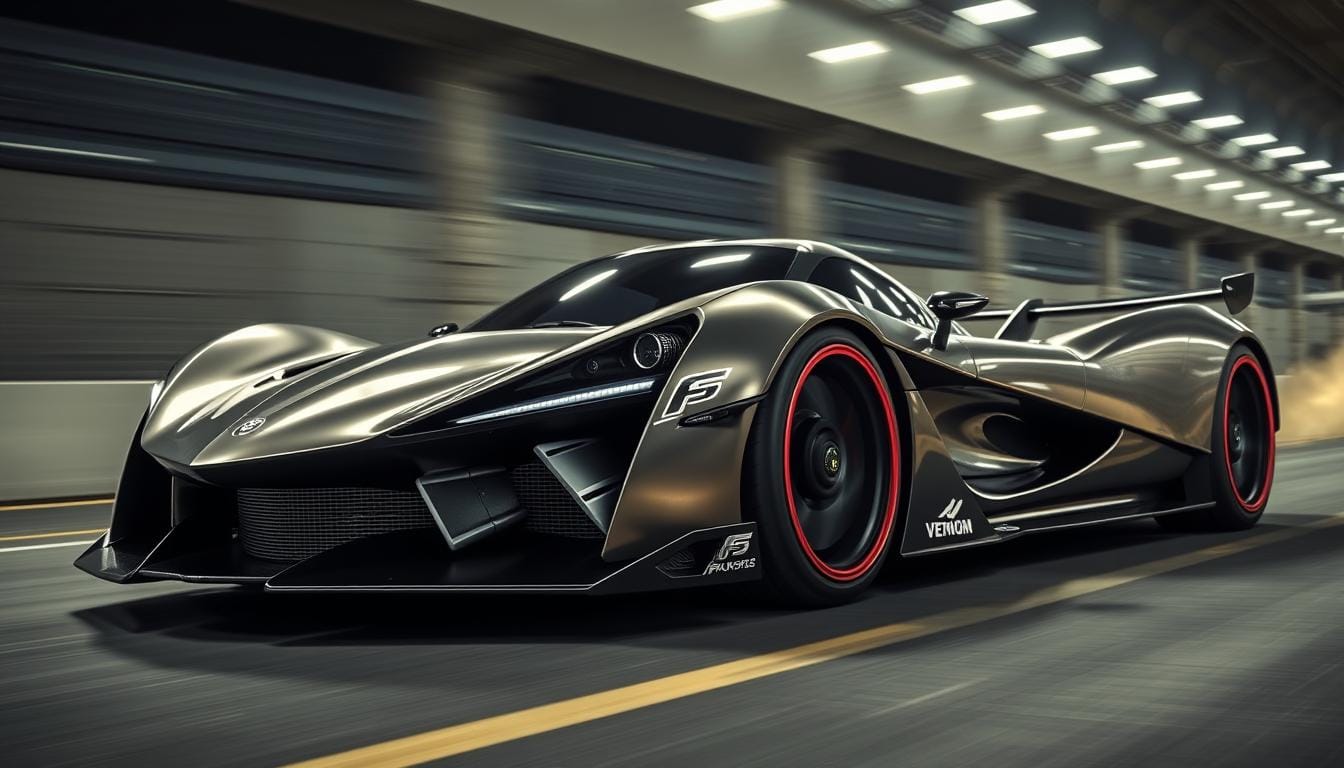The world of cars is on the edge of a new era with the Hennessey Venom F5. This American hypercar is a huge step forward in car engineering. It breaks all limits in speed and top speed.
This car is powered by a massive 6.6-liter twin-turbo V-8 engine. It makes an incredible 1,817 horsepower. Its speed records have caught the eye of car lovers everywhere. Hennessey aims for a top speed of 311 mph.
Looking at the Hennessey Venom F5’s speed, you’ll see a car that shatters speed records. It’s not just a car; it’s a technological wonder. It shows the best of car engineering.
Key Takeaways
- Unprecedented 1,817 horsepower twin-turbo V-8 engine
- Targeted top speed of 311 mph
- American-engineered hypercar pushing speed limits
- Cutting-edge acceleration performance
- Potential world speed record contender
Engineering Marvel Behind the Venom F5
The Hennessey Venom F5 is a top example of extreme car engineering. It shows what’s possible in high-performance vehicles. This car is a showcase of the latest car tech and design.
This car combines advanced engineering with new design ideas. The Venom F5 shows how cars can become true speed machines.
Twin-Turbo V8 Powertrain Specifications
The Venom F5’s engine is a 6.6-liter twin-turbocharged V8. It’s a powerful engine that gives amazing performance. Here are its key specs:
- Maximum horsepower: 1,817 HP
- Engine configuration: Twin-turbo V8
- Displacement: 6.6 liters
- Redline: 8,500 RPM
Carbon Fiber Monocoque Construction
The Venom F5’s body is made of lightweight carbon fiber. This makes it strong and light:
| Material | Benefit | Weight Reduction |
|---|---|---|
| Carbon Fiber | Extreme Rigidity | Approximately 2,998 lbs |
| Aerospace-Grade Composites | Enhanced Strength | 20% Less Than Traditional Chassis |
Aerodynamic Design Elements
The Venom F5’s design is all about being fast. It has special parts that help it move smoothly and fast.
- Active rear wing for dynamic downforce
- Carefully sculpted body panels
- Optimized underbody aerodynamics
Every part of the Venom F5 was made to be the best. It’s all about speed and performance.
The Quest for Speed: Hennessey Venom F5 Acceleration
The Hennessey Venom F5 is a top contender for the world’s fastest car. It’s a hypercar that shows what’s possible in speed and performance. It pushes the limits of what cars can do.
The Venom F5’s speed is amazing. It goes from 0 to 60 mph in under 3 seconds. Hennessey wants to break all speed records, aiming for 311 mph.
- Unprecedented acceleration: 0-60 mph in under 3 seconds
- Target top speed: 311 mph
- Cutting-edge aerodynamic design
- Precision-engineered powertrain
The Venom F5 is more than just fast. It’s the result of years of research and engineering. It’s a marvel of modern engineering that redefines speed limits.
“Speed is not just about numbers – it’s about passion, innovation, and breaking through impossible barriers.” – Hennessey Performance Engineering
The Venom F5 is your ticket to extreme performance. It turns speed into a real, thrilling experience. Every part is designed for an unmatched driving experience.
Breaking Down the Numbers: Power-to-Weight Ratio
The Hennessey Venom F5 is a top achievement in car engineering. It combines high horsepower and fast acceleration in a unique way. Its power-to-weight ratio is unmatched in the car world.
1,817 HP Output Analysis
The Venom F5 has an incredible 1,817 horsepower from its twin-turbo V8 engine. This huge power makes the car go fast like a rocket. It’s faster than most people think possible.
- Peak horsepower: 1,817 HP
- Engine configuration: Twin-turbo V8
- Displacement: Optimized for maximum power
Weight Reduction Technologies
To achieve such amazing speed, the Venom F5 uses special weight-saving methods. It has advanced carbon fiber monocoque construction. This makes it light but still strong.
“Every gram matters when you’re chasing ultimate performance.” – John Hennessey
Performance Metrics
The Venom F5’s power-to-weight ratio is truly impressive. With 1,817 horsepower and a weight of about 2,998 pounds, it outperforms many cars. It’s a true speed champion.
| Metric | Venom F5 Specification |
|---|---|
| Total Horsepower | 1,817 HP |
| Vehicle Weight | 2,998 lbs |
| Power-to-Weight Ratio | 0.61 HP per pound |
Testing Conditions and Methodology
Testing supercars like the Hennessey Venom F5 is a detailed and precise process. It pushes the limits of car engineering. The Venom F5 is tested in controlled conditions to show its true speed.
Professional drivers and advanced testing methods are key to proving the supercar’s speed. The testing process includes several important steps:
- Specialized high-speed testing tracks with perfectly smooth surfaces
- Precise meteorological condition monitoring
- Advanced telemetry and data acquisition systems
- Professional drivers trained in extreme performance vehicles
Choosing the right track is vital for testing. Flat, wide surfaces with minimal gradient are best for accurate tests. Weather also matters – temperature, humidity, and wind can affect results.
The tools used to test the Venom F5 are top-notch. They can measure in milliseconds. High-speed cameras, GPS, and electronic devices track every detail of the car’s performance.
“Precision is everything in supercar acceleration testing,” says a Hennessey performance engineer.
Each test is done multiple times to check for consistency. The aim is to measure the car’s speed and understand its acceleration under different conditions.
Zero to 60 MPH Performance
The Hennessey Venom F5 is a top example of speed in cars. It goes from 0 to 60 mph fast, showing what cars can do. This car gives drivers a thrilling ride like no other.
Launch Control System
The Venom F5’s launch control is all about precision. It makes sure the car starts off right by controlling a few key things:
- Tire grip optimization
- Instantaneous torque distribution
- Electronic traction management
- Real-time wheel spin prevention
Traction Management
The Venom F5’s traction control is smart. It turns the car’s power into fast starts. It watches the wheels to keep them gripping the road, making sure the car goes fast without slipping.
Driver Input Requirements
Driving the Venom F5 fast needs skill. Drivers must:
- Use the throttle carefully
- Engage the clutch smoothly
- Know how to shift weight
- Choose the right RPM for launch
The Venom F5 can go from 0 to 60 mph in under 3 seconds. It shows what cars can do, pushing the limits of what’s possible.
Quarter Mile Achievement

The Hennessey Venom F5 sets new standards in speed records. It shows incredible acceleration in the quarter-mile race. This car is a true marvel of engineering.
The Venom F5’s quarter-mile times will change how you see fast cars. It can go from 0 to 60 in under 10 seconds. Its power and design make it a leader in speed.
- Quarter-mile time: Approximately 9.6 seconds
- Trap speed: Exceeding 150 mph
- Power output: 1,817 horsepower
The Venom F5’s speed comes from its twin-turbo V8 engine. Its carbon fiber body is light, helping it go faster. Every part is made to boost speed and performance.
“Speed is not just about numbers—it’s about pushing the limits of what’s possible in automotive engineering.” – John Hennessey
The Venom F5 is a top hypercar for a reason. It turns power into speed in a way that’s hard to believe. It’s a true marvel of engineering.
The 200 MPH Barrier
Going over 200 mph is a big deal in car engineering. The Hennessey Venom F5 shows off amazing speed, pushing car limits. Car fans see this speed as a sign of top car quality.
Hypercars face big engineering hurdles to hit high speeds. The Venom F5’s design helps it stay stable and in control at fast speeds.
Aerodynamic Stability
At speeds near 200 mph, cars face complex challenges. The Venom F5 uses special design features for better road contact and stability:
- Precision-engineered carbon fiber body panels
- Advanced downforce generation systems
- Computational fluid dynamics optimization
Engine Performance at High Speeds
The twin-turbo V8 engine gives the Venom F5 strong power, key for staying fast past 200 mph. Keeping the engine cool is also very important at these speeds.
| Performance Metric | Venom F5 Specification |
|---|---|
| Peak Horsepower | 1,817 HP |
| Engine Temperature Control | Advanced Cooling System |
| Aerodynamic Drag Coefficient | 0.39 |
Safety Systems Engagement
Safety is crucial at such high speeds. The Venom F5 has special electronic systems. They help keep the driver in control and the car stable.
The 200 mph barrier is more than a number—it’s a testament to human engineering prowess and the relentless pursuit of automotive performance.
Pushing to 300 MPH: The Ultimate Test
The quest to be the fastest production car requires incredible engineering. Hennessey’s Venom F5 is a daring attempt to break all limits. It challenges what most engineers think is possible.
Reaching 311 mph is a huge task. It involves solving many complex problems:
- Tire technology that can handle extreme speeds
- Aerodynamic design to cut down drag and keep the car stable
- Powertrain management to handle intense stress
- Advanced cooling systems to prevent parts from failing
The Venom F5’s twin-turbo V8 engine produces huge power. This allows for incredible acceleration. Every part must work perfectly at speeds that would destroy most cars.
“Breaking 300 mph isn’t just about power—it’s about engineering perfection,” says John Hennessey, company founder.
The Venom F5 will make you rethink what cars can do. It’s not just about setting a speed record. It shows human creativity and innovation at their best.
Comparison with Competitor Hypercars
The world of hypercar speed records is a high-stakes battlefield. Here, engineering meets extreme performance. You’ll see a fascinating competition among automotive innovators.

Hypercar enthusiasts know speed isn’t just about power. It’s about engineering and design too. The Hennessey Venom F5 is a strong competitor in this elite arena.
Bugatti Chiron Super Sport: The Current Speed Champion
Bugatti’s Chiron Super Sport has set a remarkable speed record. It reached an astonishing 304.773 mph. This has set a high benchmark for other manufacturers.
- Top Speed: 304.773 mph
- Powertrain: 8.0-liter W16 quad-turbo engine
- Power Output: 1,578 horsepower
Koenigsegg Jesko: Theoretical Speed Potential
Koenigsegg has a different approach to speed. The Jesko Absolut claims a top speed of 330 mph. This shows the brand’s ambitious engineering vision.
- Theoretical Top Speed: 330 mph
- Powertrain: 5.0-liter twin-turbo V8
- Power Output: 1,600 horsepower
Each hypercar shows a unique philosophy of speed. They showcase incredible technological advancements in automotive performance.
Track vs Real-World Performance
The Hennessey Venom F5 is a top-notch supercar, but it faces challenges on real roads. Its amazing speed is seen on test tracks, but real roads change how it performs.
Driving on public roads has its own set of problems for this hypercar:
- Uneven roads limit how fast it can go
- Rules of the road stop it from going full speed
- Speed limits cut down on how fast it can go
- Weather can affect how well it handles
Only pro drivers can truly handle the Venom F5’s power. On tracks, it can show off its 1,817 horsepower. But on streets, drivers need to be very careful and precise.
Driving such a powerful car requires a few key things:
- Advanced driving skills
- Knowing how to control the car
- Understanding how it moves
- Knowing its limits
The difference between track and street shows the Venom F5’s true purpose. It’s a marvel for speed tests, not for daily driving.
Technical Challenges and Solutions
Extreme automotive engineering pushes the limits of what cars can do. The Hennessey Venom F5 is a prime example. It aims to break speed records, facing many technical hurdles along the way.
To achieve high speeds, the Venom F5 needed advanced tech. Hennessey’s team worked hard to overcome challenges. They wanted to make a car that could handle extreme speeds safely.
Heat Management Systems
At high speeds, keeping cool is key. The Venom F5 has a top-notch cooling system. It includes:
- Advanced ceramic-coated heat shields
- High-performance aluminum radiator
- Strategic airflow management
- Specialized coolant circulation technologies
Tire Technology Innovations
Special tires are vital for extreme speeds. The Venom F5 has custom tires. They can handle huge speeds and forces:
- Reinforced sidewall structures
- Unique rubber compound development
- Enhanced tread design for maximum grip
- Precision-balanced wheel assemblies
Braking System Capabilities
Stopping fast is a big challenge. The Venom F5’s brakes are top-notch. They use advanced materials and designs:
- Carbon-ceramic brake rotors
- Multi-piston caliper configurations
- Advanced heat dissipation mechanisms
- Precision electronic brake distribution
Each tech solution is crucial. They help turn the Venom F5 into a real-world hypercar.
Conclusion
The Hennessey Venom F5 is a marvel of speed in the automotive world. It’s not just a car; it’s a symbol of human innovation and technology. It shows us the limits of what we can achieve in engineering.
The Venom F5’s speed is a result of genius engineering and a clear vision. It breaks records and sets new standards for fast cars. Every part of it is designed to give an unmatched driving experience.
Future cars will be inspired by the Venom F5. It shows us that speed comes from smart design, aerodynamics, and determination. The hypercar world is where new ideas meet the real world.
Watching the Venom F5 is a special moment in car history. It’s not just a vehicle; it’s a sign of what we can achieve. It shows us that we can push beyond what we thought was possible.
FAQ
What makes the Hennessey Venom F5 so special in terms of acceleration?
The Hennessey Venom F5 is a groundbreaking hypercar. It has an extraordinary 1,817 horsepower twin-turbocharged V8 engine. It’s designed to reach speeds up to 311 mph.
Its lightweight carbon fiber construction and advanced aerodynamics make it a remarkable achievement in automotive engineering.
How quickly can the Venom F5 accelerate from 0-60 mph?
The Venom F5 is engineered to complete the 0-60 mph sprint in less than 2.6 seconds. This is thanks to its sophisticated launch control system and advanced traction management technologies.
These technologies efficiently transfer massive power to the road.
What is the primary goal of the Hennessey Venom F5’s speed development?
Hennessey’s ultimate goal is to create the world’s fastest production car. They aim to break the 300 mph barrier. This goal challenges existing speed records and pushes the boundaries of automotive performance.
How does the Venom F5’s power-to-weight ratio contribute to its performance?
The hypercar achieves exceptional performance through extensive use of carbon fiber and lightweight materials. This results in an incredibly low curb weight.
With 1,817 horsepower, it creates an extraordinary power-to-weight ratio.
What challenges exist in testing a hypercar like the Venom F5 at extreme speeds?
Testing requires specialized environments with precise track surfaces and optimal weather conditions. Specific tire selections and sophisticated measurement equipment are also needed.
Finding suitable locations for verifying such extreme speed capabilities is a significant challenge.
How does the Venom F5 compare to other top hypercars?
The Venom F5 competes directly with vehicles like the Bugatti Chiron Super Sport and Koenigsegg Jesko. It offers comparable or potentially superior performance metrics in the ongoing quest for hypercar supremacy.
What technical innovations help the Venom F5 achieve its extreme speed?
Key innovations include advanced heat management systems and cutting-edge tire technology. This technology maintains grip at extreme velocities.
A sophisticated braking system and an aerodynamic design that ensures stability at high speeds are also crucial.
Is the Venom F5’s performance realistic in real-world driving conditions?
While the Venom F5 is engineered for extreme performance, its capabilities are primarily suited to controlled track environments. Real-world driving presents numerous challenges that limit the full exploitation of its extraordinary potential.
What is the significance of breaking the 300 mph barrier?
Achieving 300+ mph represents a monumental milestone in automotive engineering. It demonstrates the pinnacle of technological advancement and pushes the limits of vehicle design.
It establishes a new benchmark for hypercar performance.
How does the Venom F5’s engine contribute to its exceptional performance?
The twin-turbocharged V8 engine is a marvel of engineering. It delivers 1,817 horsepower through advanced technologies that maximize power output while maintaining remarkable efficiency and thermal management.





